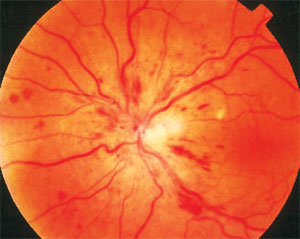 |
|
The treatment burden for anti-VEGF in eyes with CRVO over three years was an average of 18 injections at 26 visits. Click image to enlarge. |
Vascular endothelial growth factor (VEGF) inhibitors are recommended as a first-line treatment of cystoid macular edema due to central retinal vein occlusion (CRVO). However, outcomes beyond two years are less clear as there are few patients enrolled in extension studies. A retrospective analysis of a large prospectively specified observational database of patients with CRVO treated with anti-VEGF found that the overall mean change in visual acuity (VA) at 36 months was +12 letters and that macular thickness improved by a mean of -324μm from baseline. Still, the outcomes for the overall group of eyes were likely to have been worse because eyes with poor outcomes were more likely lost to follow-up.
The study identified 527 treatment-naïve patients with CRVO from the RVO module of the Fight Retinal Blindness! registry, with a mean age of 71 and a VA of 41 letters. In all eyes, the mean VA change was +10 letters, with 44% gaining and 14% losing ≥15 letters. A total of 37% achieved a final VA ≥70, while 30% achieved ≤35 letters. The mean central subfield thickness (CST) change was -306µm. The adjusted mean VA change was similar with each VEGF inhibitor (+12 letters) despite a significant difference in adjusted mean CST change with aflibercept (-310µm), ranibizumab (-258µm) and bevacizumab (-216µm). Those who switched anti-VEGF treatment (19%) gained 11 letters similar to non-switchers (69%) but with more injections (20 vs. 10).
Eyes that switched to steroid treatment (12%) had a lower mean baseline VA of 38 letters, and 46% had a final VA ≤35 letters and no mean change in VA from baseline. The mean VA change in eyes with trial-eligible baseline VA (19 to 73 letters, 68%) was +7 letters. Eyes outside this range with very poor baseline VA (<19 letters, 24%) gained 22 letters, and eyes with very good baseline VA (>73 letters, 8%) lost vision by seven letters.
Completers (49%) had a median of 18 injections over 26 visits. Suspension of therapy >180 days occurred in 27% of eyes, but only 12% of eyes had no macular edema during that time. Treatment status was known in 68% of eyes—55% were still receiving injections at three years while 45% had suspended therapy.
“We believe it is important to account for the outcomes of all eyes whether they were completers, as there is potential for selection bias in ‘completers-only analyses’ especially as outcomes may further deteriorate in eyes that drop out,” the researchers wrote in their paper. “The 18 injections at 26 visits over three years that we found for completers is a high treatment burden.” The team believes that better outcomes may be achieved with longer-lasting agents.
While they noted that their study improved prognostication out to three years for patients starting VEGF therapy for CRVO in routine care, the researchers noted, “Tolerating some disease activity without treatment may be acceptable in some patients, but in others, the burden of therapy and what may be perceived as a less than satisfactory visual response can cause a significant number to give up or fail to attend.”
Hunt A, Nguyen V, Bhandari S. Central retinal vein occlusion 36-month outcomes with anti-vascular endothelial growth factors: the Fight Retinal Blindness! registry. Ophthalmology. November 9, 2022. [Epub ahead of print]. |


